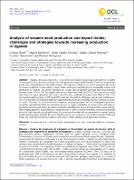Analysis of sesame seed production and export trends; challenges and strategies towards increasing production in Uganda

View/
Date
2021-01Author
Wacal, Cosmas
Basalirwa, Daniel
Okello-Anyanga, Walter
Murongo, Marius Flarian
Namirembe, Caroline
Malingumu, Richard
Metadata
Show full item recordAbstract
Sesame (Sesamum indicum L.) is one of the most ancient oilseed crops cultivated for its edible oil and uses in food. Sesame seeds are very nutritious and confer health benefits. However, its potential production in Uganda has not been fully realized. The objective of this review was to summarize the trends in sesame production, export quantity, export value, challenges, and strategies for sustainable sesame seed production in Uganda. The review revealed the sesame seed production and area harvested generally increased from 1996 to 2007 but significantly decreased between 2008 and 2018. The review also revealed that while the export quantities and values were low, they gradually increased from 2009 to 2016. The decreased production between 2008 and 2016 could have been due to challenges such as pests and diseases, loss of soil fertility, prolonged drought, poor agronomic practices, poor yielding varieties, and lack of access to credit. Therefore, it is recommended to improve breeding programs and soil management practices; strengthen agricultural credits and extension services to support marketing of sesame seeds; and improve agronomic practices and farmer knowledge on improved techniques such as sowing methods, plant spacing, intercropping practices, pests and disease control measures. These could boost sesame production in Uganda given the high domestic and global demand for sesame seeds and provide an opportunity to expand sesame production throughout Uganda. Research should focus on how to increase seed yield on farmers’ fields and bridge the yield gap between researchers and farmers while adopting good agronomic practices.
Collections
- Research Articles [28]
